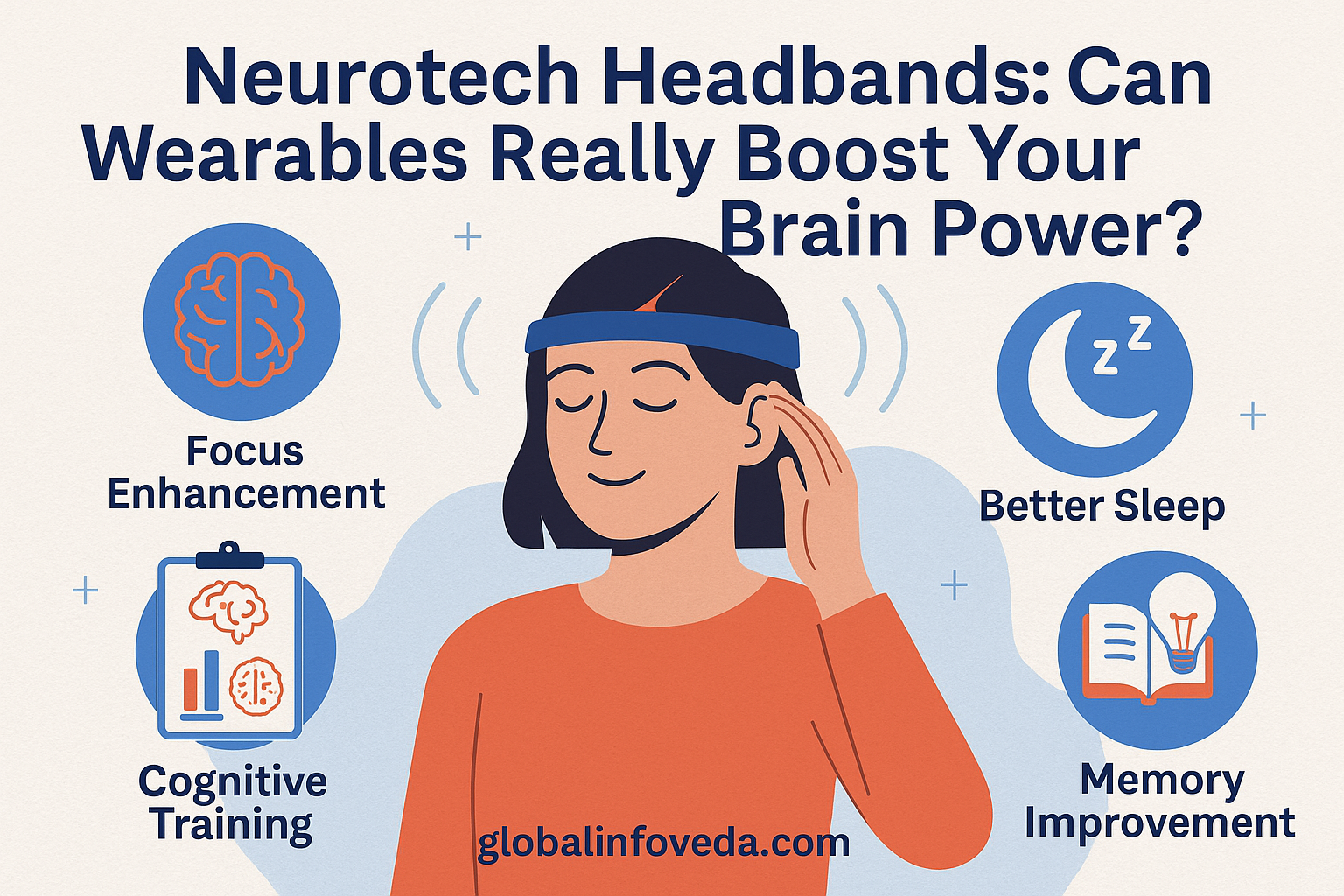🧠 Can Wearables Really Boost Your Brain Power?
In 2025, the fusion of neuroscience and wearable tech has entered a bold new frontier: neurotech headbands. Marketed as cognitive enhancers, stress reducers, focus boosters, and meditation trainers, these sleek, sensor-packed bands are worn across the forehead and promise to tune your mental state with the push of a button.
From corporate boardrooms and college libraries to yoga studios, esports arenas, and mental wellness clinics, neurotech wearables are gaining traction as tools to unlock human potential in an age of digital overwhelm, cognitive fragmentation, and attention fatigue. But how much of their promise is grounded in science—and how much is futuristic hype?
📡 What Are Neurotech Headbands?
Neurotech headbands are lightweight, EEG-based devices that sit snugly across the forehead, equipped with advanced biosensors designed to monitor and modulate brainwave activity. Their goal is to create real-time awareness of your mental state and help steer it toward optimal zones—whether focus, calm, creativity, or sleep.
Key Components Include:
- EEG electrodes to detect real-time brainwave patterns: alpha (relaxation), beta (focus), theta (creativity), delta (deep sleep), and gamma (high-level cognition)
- Biofeedback dashboards accessible via mobile apps for visualized trend tracking
- Built-in entrainment tools: Binaural beats, haptic pulses, guided breath tones
- Adaptive LED visuals for real-time cueing
- Machine learning algorithms that track your neural signature and evolve over time
Popular brands and uses:
- Muse 3 / Muse S: Meditation, sleep, and real-time stillness feedback
- FocusCalm: Productivity-focused training with gamified performance
- Neuphony (India): EEG headbands for personalized neuro-wellness in schools and companies
- Neurable: Gaming-grade neurotech optimized for focus under pressure
- Halo Neuroscience / Kernel Flow: Elite cognitive tuning and brain-mapping
🧠 How They Claim to Work
Neurobands typically offer multi-mode programs that leverage the brain’s natural neuroplasticity to guide it toward productive mental states:
1. Focus Mode:
- Boosts beta waves using light, tone, and rhythmic cueing
- Real-time feedback when attention drifts off-task
- Syncs with Pomodoro timers and noise-blocking headphones
2. Calm Mode:
- Increases alpha-theta coherence to shift from stress to relaxation
- Ideal for anxiety management, pre-sleep wind-down, and mindfulness
3. Sleep Mode:
- Uses slow-wave entrainment and ambient sensory triggers
- Syncs with circadian data from your smart ring or phone
4. Meditation Mode:
- Offers breathing visuals, guided mantras, and gamified stillness rewards
- Measures mind-wandering, posture, and HRV during seated sessions
Bonus Features Include:
- AI nudging: Suggests sessions based on your stress or sleep score
- Performance analytics: Personalized weekly brain fitness reports
- Integrations with productivity apps: Link sessions with task planning or journaling
⚙️ Who’s Using Them—and Why?
Students & Knowledge Workers:
- Improve study retention, exam prep stamina, and reduce burnout
Entrepreneurs & Executives:
- Access deeper creative flow and faster mental switching
Athletes & Esports Players:
- Use mental warmups to prep for peak performance
- Track reaction time and recovery zones pre/post training
Meditators, Therapists & Mindfulness Guides:
- Deepen meditative absorption, emotional regulation, and somatic quietude
Neurodivergent Users (ADHD/Anxiety):
- Train self-regulation, identify triggers, and build concentration scaffolding
- Non-pharmacological support for emotional variability
Corporate Wellness Programs (2025):
- Integrate neurobands into brain break rooms
- Used in onboarding, focus bootcamps, and fatigue audits
📊 Do They Actually Work?
Scientific Evidence (2020–2025):
- Multiple meta-analyses support EEG neurofeedback for ADHD, anxiety, and executive functioning
- Studies at Stanford, Harvard, and IIT Delhi show average improvements of 20–30% in attention span with consistent use (8+ weeks)
- Muse’s internal data shows that over 70% of users report better sleep or calmness within 2 weeks
User Factors Impacting Efficacy:
- Adherence to usage frequency (at least 4 sessions/week)
- Psychological openness and baseline neuroplasticity
- Environment and external stress levels
Expert View:
- “These are not hacks—they are habits made measurable.” – Dr. Sameer Dhar, Neurotech Researcher at NIMHANS
Limitations:
- Signal noise in motion-heavy environments
- Confusion around “data interpretation” by non-specialists
- Long-term cognitive impact studies still ongoing
🔬 Neurotech Innovations in 2025
- Emotion-aware neurofeedback: Real-time mood labeling with AI auto-journaling
- EEG + heart rate + skin temp stacks for holistic nervous system tracking
- Synchronized group headband sessions in yoga studios and therapy pods
- Closed-loop neural interfaces for adaptive entrainment based on bio-signal flux
- Neuro-twin dashboards: Your digital brain avatar evolves alongside your training
🔮 The Future of Brain Optimization
Emerging Frontiers:
- Mind-controlled interfaces: Type, draw, or browse with just thought
- Dream mapping: Visualizing REM brainwave activity in dream journals
- Neuroethics + Data Sovereignty: Ensuring cognitive biometrics stay private
- Digital mental fitness passports: Wellness-linked insurance discounts or travel perks
- School-wide brain literacy programs: Teaching focus and regulation with wearables from age 10+
🧾 Final Word
Neurotech headbands may not turn you into a genius overnight—but they could be your most personal mirror into how your brain feels, thinks, and changes. As we enter the era of neural self-awareness, these devices are not shortcuts but trainers—nudging us toward deeper focus, sharper calm, and smarter recovery.
With careful use and ethical design, neurobands may empower us to tune our minds just as we train our bodies—consciously, precisely, and sustainably.
📢 For advanced brain-tech insights, neurofeedback guides, and holistic wellness trends, visit GlobalInfoVeda.com
